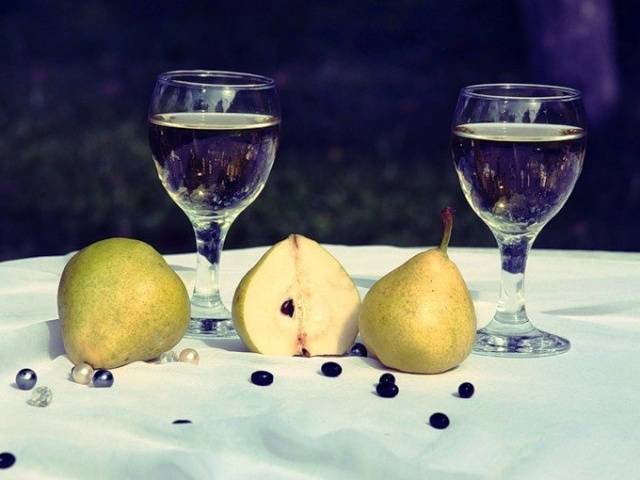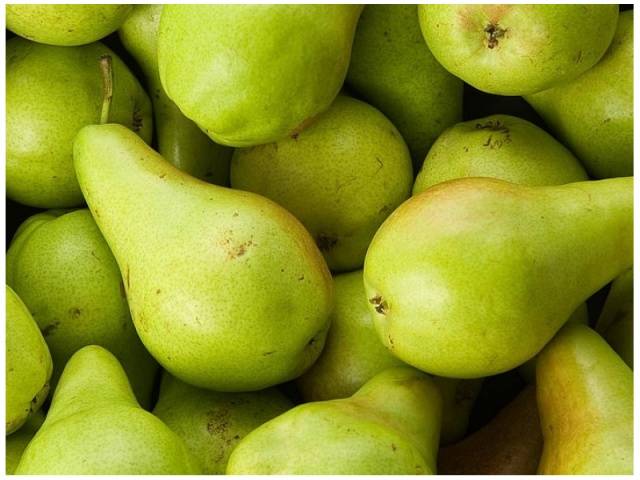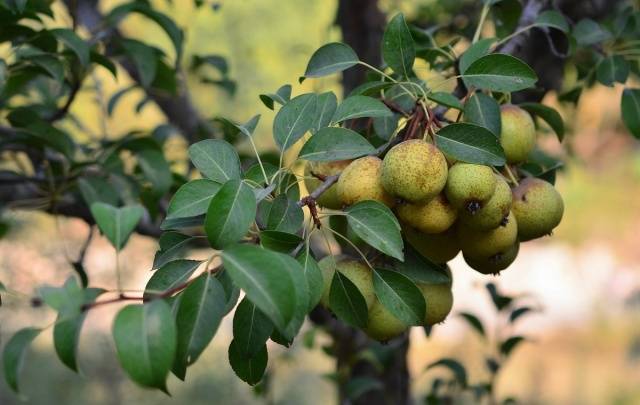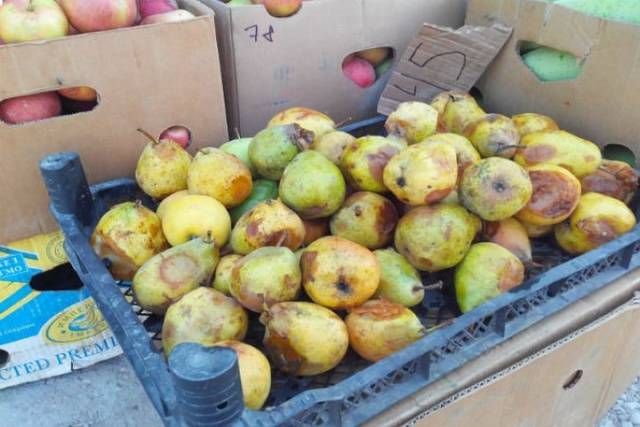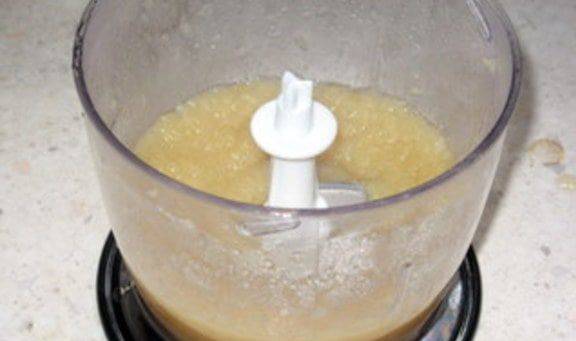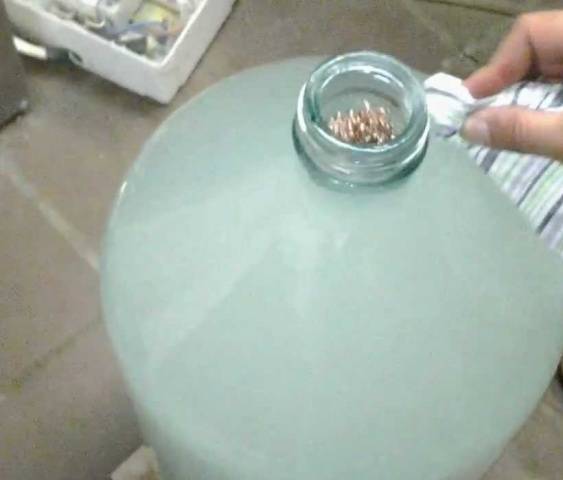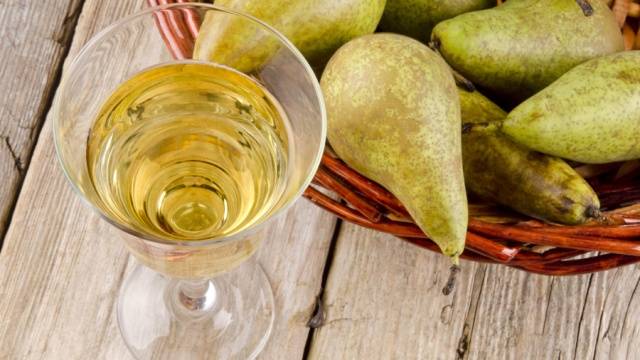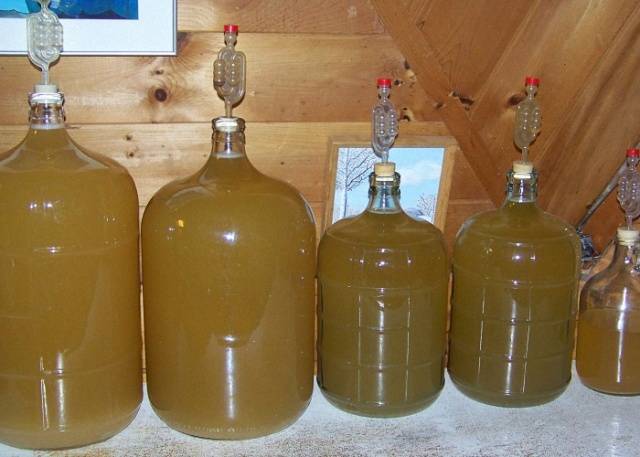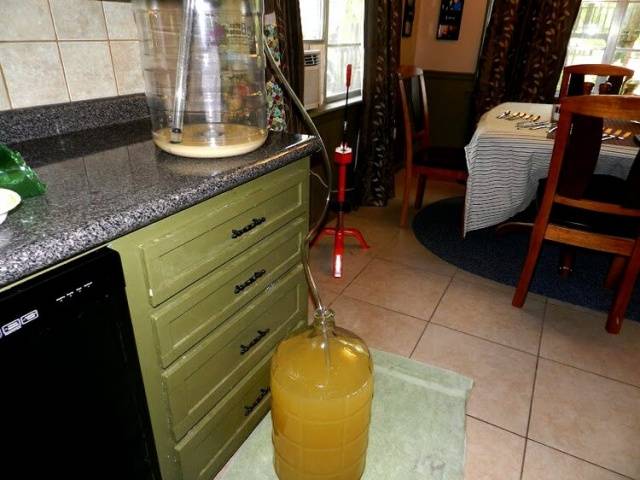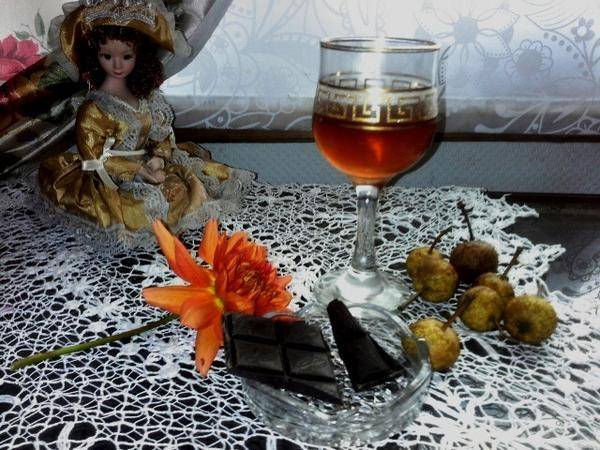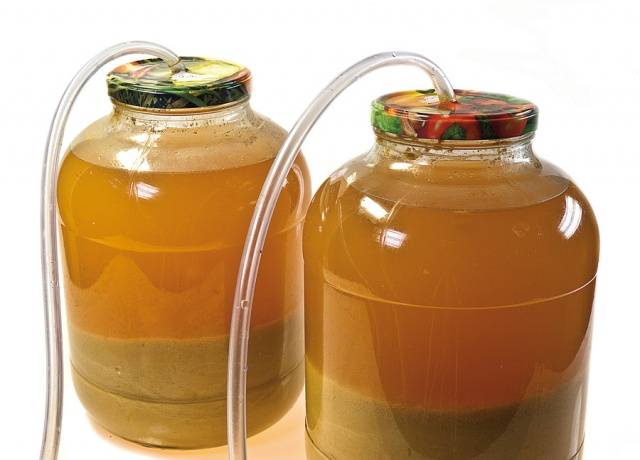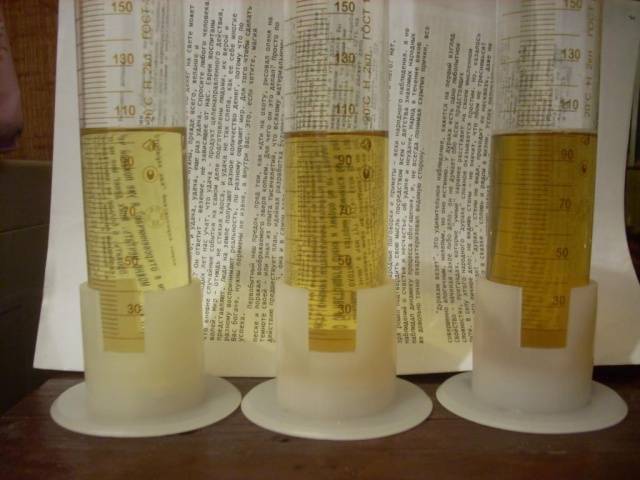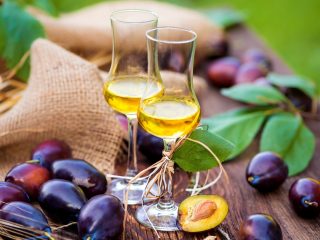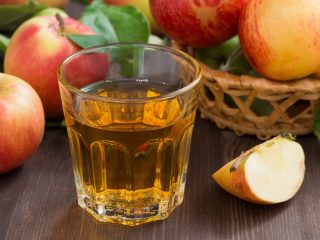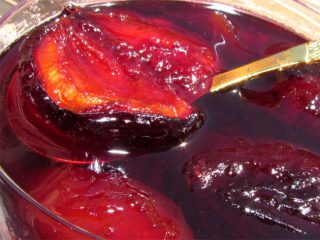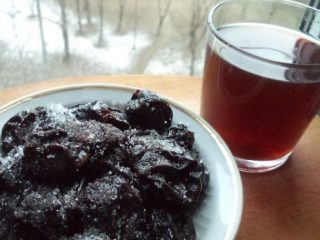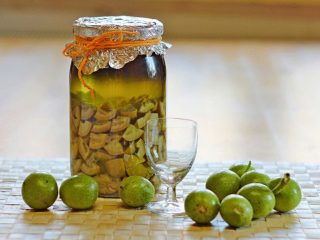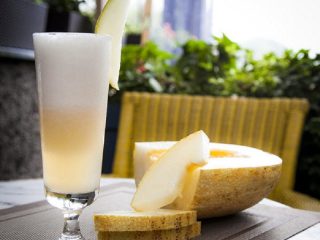Content
At least one pear tree must grow and bear fruit abundantly on each site. Sweet juicy fruits refresh well, contain a lot of vitamins, iron, potassium, zinc, copper. Winter varieties usually have a rich flavor and diversify our diet when prices for fruits in stores become obscenely high.
Summer ones simply disappear - unfortunately, pears are rarely processed into juice or other preparations. It's a shame, of course, and wasteful too. Meanwhile, many delicious supplies, and even alcoholic drinks, can be prepared from these fruits. Today we will offer you a simple recipe for homemade pear wine.
Pear as a raw material for wine
Pear is not the most suitable material for wine production. Alcoholic drinks from it can turn out to be sweet, aromatic and strong, or they can deteriorate during preparation or come out cloudy and musty. This is due to the fact that the varieties have different densities and fermentability, contain sugar, acid and tannins in different quantities.
Of course, experienced winemakers take all this into account and do not make mistakes, but this or other similar articles are not intended for them. You will have to use trial and error to find the best recipe for homemade pears growing on your backyard. We will tell you what you need to pay attention to, how to avoid the most common mistakes.
Oddly enough, the best raw material for pear wine at home would be wild - it contains enough acid and tannins. But the drink will turn out to be "flat", practically devoid of aroma. Dessert varieties in their pure form are absolutely not suitable for the production of pear wine. They must be mixed with wild or sour apples, or acid must be added.
The subtleties of making wine
In order for the wine to turn out tasty and have a delicate aroma, several points must be taken into account during its production. If you ignore them, you will end up with a cloudy tasteless alcoholic drink, or it will deteriorate even at the fermentation stage.
- The acidity of dessert pears is about 2 times lower than that of apples or grapes, and in the production of wine it should be from 6 to 15 g per liter. The deviation from the norm makes fermentation impossible or very weak. Remember that even the sweetest pears still contain acid. For example, the variety Naryadnaya Efimova includes about 0.13%, and Noyabrskaya - 0.9%.
- The sugar content of most varieties is low. They seem sweet only because of their low acidity. It is impossible to make wine from pears without adding sugar.
- From overripe fruits, you can only drive out moonshine - they are absolutely not suitable for the production of light alcoholic beverages.
- Tannins, abundant in some pear varieties, make the wine cloudy.
- It is imperative to add water to the wort. From 10 kg of even the most juicy pears, you can get no more than 4 liters of juice.
- Before making pear wine, think about what sourdough you will use (and you will definitely need it). Plain, the preparation method of which is described in the article Grape wine at home: a simple recipe will not add aroma to an already "flat" drink.You can prepare a sourdough in the same way as grape, using raspberries, strawberries or lees from blackcurrant wine production. sea buckthorn.
- The pulp of the pear darkens quickly. In order not to get a putrid color drink at the output, immediately after crushing the fruits into 10 liters of wort, add 1/3 teaspoon of ascorbic acid.
- Tannin, found in large quantities in some varieties of pears, is different from apple. It does not help to clarify the wine, but makes it cloudy and tart. To reduce the content of this substance, crushed pears are left in a wide open container for 1-2 days before adding sugar and water. During this time, most of the tannins are oxidized under the influence of oxygen.
Raw materials and containers for wine
It is unlikely that you will prepare wine from pears in barrels. Glass cylinders are washed with hot soda solution and rinsed well before use. Banks with a volume of 3-5 liters can be sterilized.
Pears for wine production must be collected at the stage of technical ripeness (when the seeds have just begun to color), spread out in a thin layer in a cool room and leave for 2-7 days. The wild game should ripen for 1-2 weeks. If the fruits lie down a little, the drink will be devoid of aroma.
Pears should not be washed - this way you will destroy the "wild" yeast, which is already scarce on the surface of this fruit. It is also not necessary to wipe them with a cloth - the fruits of technical ripeness are torn from the tree, and not harvested on the ground.
Pear wine
It is easier for inexperienced winemakers to make dessert wine from pears than dry wine. This is because a lot of water and sugar will be added to the wort. We will give you a few simple recipes that should serve as a guiding thread for you in making wine, because there are so many varieties of this wonderful fruit.
Wine from dessert varieties
We will assume that your pears are moderately sweet, juicy, and have a pleasant aroma.
You will need:
- dessert pears - 9 kg;
- sugar - 3 kg;
- malic acid - 25 g;
- sourdough - 3% of the wort volume;
- water - 4 l.
We've given the average amount of additives as dessert pears contain varying amounts of acid and sugar.
After the pears have settled for the proper time, cut them into 4 pieces and remove the core. Puree the fruit, add ascorbic acid (1/3 teaspoon per 10 L), stir and let stand in an open container for 24 to 48 hours to oxidize the tannins.
Add water, 1/4 of sugar, sourdough and acid to the wort. Stir well, cover with a clean cloth and leave in a warm (20-26 degrees) place. When oxygen is available, fermentation will begin in about 1-2 days. If this did not happen, try the wort, if it is sweet to sugary - add a little water, sour - sugar.
After 3-4 days of active fermentation, strain the pulp, trying not to disturb the sediment, pour it into a glass bottle, filling it no more than 3/4 full. Place a water seal or put on a rubber glove punctured in one finger. Remove the wine for fermentation at a temperature of 18-24 degrees, protecting the cylinders from direct sunlight.
Sugar is added in parts, after dissolving it with a small amount of wort. The first time we added it before the start of fermentation, the second - after straining the pulp while pouring the wine into a glass container. Then sugar is added after 3-4 days, having previously tasted the wort.
After about a month and a half, when the odor trap stops releasing bubbles of carbon dioxide or the glove falls off, drain the pears from the sediment, bottle and take to a cool place (10-12 degrees) for ripening. It will be sour-bitter and cloudy.
First, every two weeks, and then less often, remove the prepared wine from the lees, pouring it into a clean bowl.It will take 3 to 6 months to fully mature.
Sugar, honey, or alcohol can be added before sealing wine bottles. To obtain a light drink, it is left as it is, syrup is poured into a semisweet drink, and alcohol is added to increase the strength.
The bottles are stored horizontally, preferably the temperature should not exceed 12 degrees.
Wine from dessert varieties and wild game
Although this recipe is simple, pear wine at home will turn out to be very tasty.
Take:
- dessert pears - 6 kg;
- wild pears - 2 kg;
- sugar - 3 kg;
- malic acid - 20 g;
- sourdough - 2% of the wort volume;
- water - 4.5 liters.
This wine is prepared in exactly the same way as described in the previous recipe, just the wild puree is added to the wort.
It should be remembered that wild pears should be picked at the stage of technical maturity and lie down for 1-2 weeks.
The wine is expected to be light, sweet and aromatic.
Pear and apple wine
Homemade wine made from pears and sour apples is the easiest to make. In addition, it does not require the addition of acid and is easier to clarify. Apples of varieties Antonovka or Simirenko are excellently combined with pears.
You will need:
- dessert pears - 5 kg;
- sour apples - 3 kg;
- sugar - 3 kg;
- sourdough - 2-3% of the wort volume;
- water - 4 l.
Cut unwashed sour apples into 4 pieces and remove the seeds. Grind them together with the pears in the puree. Add ascorbic acid.
Apple wine and pears are prepared in the same way as described in the first recipe. Remember to taste the wort at all stages of the preparation so that you can add sugar or water on time if necessary.
Clarification of wine
Clarification of wine called pasting. Especially cloudy comes out a drink made from some pears. Usually it turns out to be so unattractive that it is embarrassing to put the wine on the table.
To correct the situation, special substances are added to alcohol that bind unwanted microparticles, which is why they are collected in flakes and fall to the bottom of the container as a sediment. The pasting does not affect the taste of the drink, it only makes it transparent and can slightly extend the shelf life. To clarify wine, use:
- gelatin;
- isinglass;
- egg white;
- casein (milk);
- bentonite (white refined clay);
- tannin.
For pasting alcoholic beverages from pears, gelatin is most often used. It is consumed about 0.5-2 g per 10 liters. Gelatin is soaked with water 1: 1 for a period from several hours to a day. Then pour the same volume of boiling water and stir until the lumps disappear. Wine in a bottle is twisted with a funnel and gelatin is poured in a thin stream. The container is shaken, sealed and left to stand in the cold for 2-3 weeks. Then it is removed from the sediment, bottled, and sealed.
Before proceeding with pasting, pour a little wine into small identical bottles, dissolve different amounts of gelatin in it. After 3-4 days it will be clear which result is the best.
Conclusion
Making pear wine is not the easiest process. But you can get a wonderful drink that you can hardly buy at the store. In addition, you will save the harvest of early and middle varieties, because only late pears are stored for a long time.

